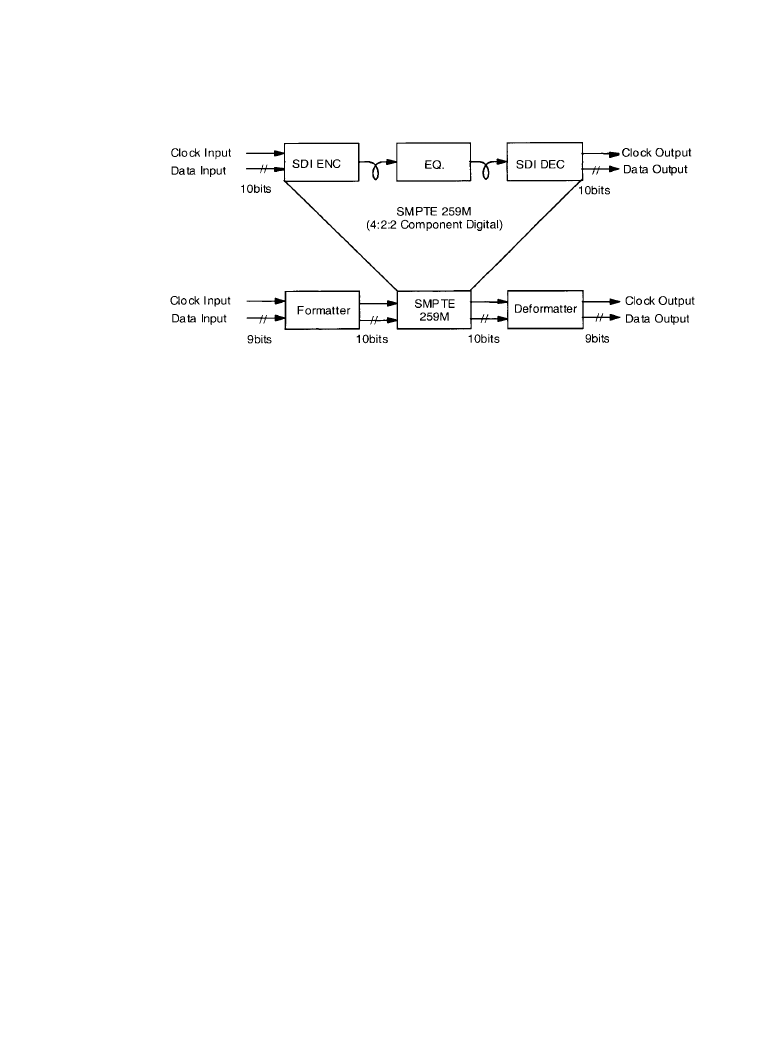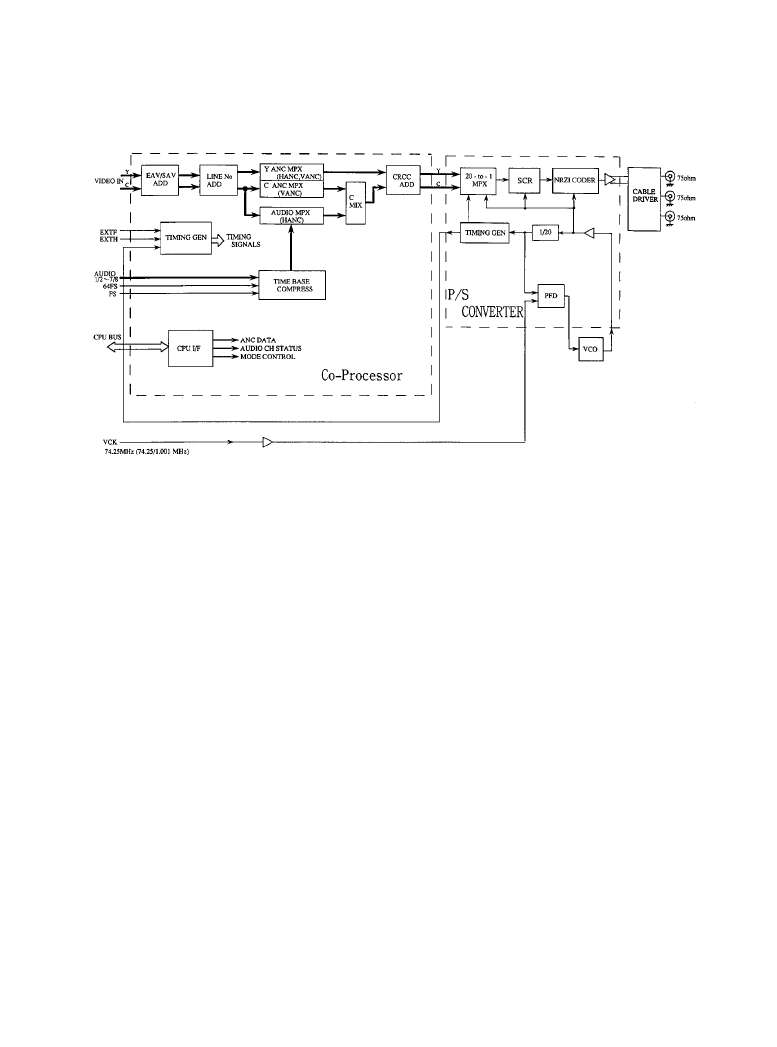ВУЗ: Казахская Национальная Академия Искусств им. Т. Жургенова
Категория: Книга
Дисциплина: Не указана
Добавлен: 03.02.2019
Просмотров: 21736
Скачиваний: 19

Serial Digital Video/Audio Systems 8-13
8.2.2b
Error Detection and Handling
SMPTE Recommended Practice RP 165-1994 describes the generation of error detection check-
words and related status flags to be used optionally in conjunction with the serial digital interface
[2]. Although the RP on error detection and handling (EDH) recommends that the specified
error-checking method be used in all serial transmitters and receivers, it is not required.
Two checkwords are defined: one based on a field of active picture samples and the other on a
full field of samples. This two-word approach provides continuing error detection for the active
picture when the digital signal has passed through processing equipment that has changed data
outside the active picture area without re-calculating the full-field checkword.
Three sets of flags are provided to feed-forward information regarding detected errors to help
facilitate identification of faulty equipment, and the type of fault. One set of flags is associated
with each of the two field-related checkwords. A third set of flags is used to provide similar
information based on evaluating all of the ancillary data checksums within a field. The check-
words and flags are combined in an error detection data packet that is included as ancillary data
in the serial digital signal. At the receiver, a recalculation of check-words can be compared to the
error detection data packet information to determine if a transmission error has occurred.
All error flags indicate only the status of the previous field; that is, each flag is set or cleared
on a field-by-field basis. A logical 1 is the set state and a logical 0 is the unset state. The flags are
defined as follows:
•
EDH, error detected here: Signifies that a serial transmission data error was detected. In the
case of ancillary data, this means that one or more ANC data blocks did not match its check-
sum.
•
EDA, error detected already: Signifies that a serial transmission data error has been detected
somewhere upstream. If device B receives a signal from device A and device A has set the
Table 8.2.1 SMPTE 272M Mode Definitions
A (default)
Synchronous 48 kHz, 20 bit audio, 48 sample buffer
B
Synchronous 48 kHz, composite video only, 64 sample buffer to receive 20
bits from 24 bit audio data
C
Synchronous 48 kHz, 24-bit audio and extended data packets
D
Asynchronous (48 kHz implied, other rates if so indicated)
E
44.1 kHz audio
F
32 kHz audio
G
32-48 kHz variable sampling rate audio
H
Audio frame sequence (inherent in 29.97 frame/s video systems, except 48
kHz synchronous audio—default A mode)
I
Time delay tracking
J
Non-coincident channel status Z bits in a pair.
Downloaded from Digital Engineering Library @ McGraw-Hill (www.digitalengineeringlibrary.com)
Copyright © 2004 The McGraw-Hill Companies. All rights reserved.
Any use is subject to the Terms of Use as given at the website.
Serial Digital Video/Audio Systems

8-14 Audio Networking
EDH flag, when device B retransmits the data to device C, the EDA flag will be set and the
EDH flag will be unset (if there is no further error in the data).
•
IDH, internal error detected here: Signifies that a hardware error unrelated to serial transmis-
sion has been detected within a device. This feature is provided specifically for devices that
have internal data error-checking facilities.
•
IDA, internal error detected already: Signifies that an IDH flag was received and there was a
hardware device failure somewhere upstream.
•
UES, unknown error status: Signifies that a serial signal was received from equipment not
supporting the RP 165 error-detection practice.
Individual error status flags (or all error status flags) may not be supported by all equipment.
8.2.2c
Packetized Data Transport
The SMPTE 305M standard specifies a data stream used to transport packetized data within a
studio/production center environment [3]. The data packets and synchronizing signals are com-
patible with SMPTE 259M, as illustrated in Figure 8.2.2. Other parameters of the protocol also
are compatible with the 4:2:2 component SDI format.
The data stream is intended to transport any packetized data signal over the active lines that
have a maximum data rate up to (approximately) 200 Mbits/s for a 270 Mbits/s system or
(approximately) 270 Mbits/s for 360 Mbits/s system. The maximum data rate can be increased
through use of a defined extended data space.
The SMPTE 305M standard describes the assembly of a stream of 10-bit words. The resulting
word stream is serialized, scrambled, coded, and interfaced according to SMPTE 259M and ITU-
R BT.656. The timing reference signals (EAV and SAV) occur on every line. The signal levels,
specifications, and preferred connector type are as described in SMPTE 259M.
Figure 8.2.2
SMPTE 305M system block diagram. (
After [3].)
Downloaded from Digital Engineering Library @ McGraw-Hill (www.digitalengineeringlibrary.com)
Copyright © 2004 The McGraw-Hill Companies. All rights reserved.
Any use is subject to the Terms of Use as given at the website.
Serial Digital Video/Audio Systems

Serial Digital Video/Audio Systems 8-15
8.2.2d
Optical Interconnect
SMPTE 297M-1997 defines an optical fiber system for transmitting bit-serial digital signals that
conform to the SMPTE 259M serial digital format (143 through 360 Mbits/s). The standard's
optical interface specifications and end-to-end system performance parameters are otherwise
compatible with SMPTE 292M, which covers transmission rates of 1.3 through 1.5 Gbits/s.
During the Summer of 2000, a major revision was undertaken of SMPTE 297M. The docu-
ment—proposed at this writing—updated applicable references and included new information
on important elements covered by the standard. Among the new information were four appendi-
ces examining the following subjects:
•
Maximum transmission distance range
•
Minimum transmission distances
•
Computing damage thresholds
•
A comprehensive glossary of fiber optic terms
8.2.3
High-Definition Serial Digital Interface
In an effort to address the facility infrastructure requirements of HDTV, the SMPTE and BTA
developed a standard for digital serial transmission of studio HDTV signals [4]. The overall
transmission rate for transporting a digital studio HDTV signal (1125-line, 2:1 interlace, with
10-bit component sampling) is approximately 1.5 Gbits/s. The active payload is on the order of
1.2 Gbits/s (for 1035/1080 active lines). The transmission of video signals at these bit rates rep-
resents a far more difficult technical challenge than serial distribution at 270 Mbits/s used for
conventional television signals.
The introduction of the serial digital interface for conventional video (SMPTE 259M) was
well received by the television industry and has become the backbone of digital audio/video net-
working for broadcast and post production installations around the world. SDI is ideally suited to
the task of transporting uncompressed component/composite digital video and multichannel
audio signals over a single coaxial cable. To emulate the same level of operational usability and
system integration of conventional television equipment in the HDTV world, the implementation
of a high-definition serial digital interface (HD-SDI) system—based on an extension of SMPTE
259M—was essential.
Work on the HD-SDI system began in 1992 under the auspices of SMPTE and BTA. The end
result of these efforts was the BTA document BTA S-004 (May 1995), followed closely by
SMPTE 292M-1996, both with similar technical content.
The source formats of SMPTE 292M adhere to those signal characteristics specified in
SMPTE 260M and 274M. In particular, the field frequencies of 59.94 Hz and 60.00 Hz, and
active line numbers of 1035/1080 are used by HD-SDI. Table 8.2.2 lists the basic parameters of
the input source formats.
Subsequently, a revision of SMPTE 292M was undertaken, resulting in SMPTE 292M-1998
[5]. The revised source format parameters are given in Table 8.2.3. Note that the total data rate is
either 1.485 Gbits/s or 1.485/1.001 Gbits/s. In the table, the former is indicated by a rate of “1”
and the later by a rate of “M,” which is equal to 1.001.
Downloaded from Digital Engineering Library @ McGraw-Hill (www.digitalengineeringlibrary.com)
Copyright © 2004 The McGraw-Hill Companies. All rights reserved.
Any use is subject to the Terms of Use as given at the website.
Serial Digital Video/Audio Systems

8-16 Audio Networking
Table 8.2.2 SDI Reference Source Format Parameters
(
After [4].)
Reference Document
SMPTE-260M
SMPTE-274M
SMPTE-274M
Parallel word rate (each
channel
Y
,
C
R
/
C
B
)
74.25 Mword/s
74.25 Mword/s
74.25/1.001 Mword/s
Lines per frame
1125
1125
1125
Words per active line (each
channel
Y
,
C
R
/
C
B
)
1920
1920
1920
Total active line
1035
1080
1080
Words per total line (each
channel
Y
, C
R
/
C
B
)
2200
2200
2200
Frame rate
30 Hz
30 Hz
30/1.001 Hz
Total Fields per frame
2
2
2
Total data rate
1.485Gbits/s
1.485Gbits/s
1.485/1.001 Gbits/s
Field 1 EAV V = 1
Line 1121
Line 1124
Line 1124
Field 1 EAV V = 0
Line 41
Line 21
Line 21
Field 2 EAV V = 0
Line 558
Line 561
Line 561
Field 2 EAV V = 0
Line 603
Line 584
Line 584
EAV F = 0
Line 1
Line 1
Line 1
EAV F = 1
Line 564
Line 563
Line 563
Table 8.2.3 Source Format Parameters for SMPTE 292M
(
After [5].)
Reference
SMPTE
Standard
260M
295M
274M
296M
Format
A
B
C
D
E
F
G
H
I
J
K
L
M
Lines per frame
1125
1125
1250
1125
1125
1125
1125
1125
1125
1125
1125
750
750
Words per
active line
(each channel
Y, C
B
/
C
R
)
1920
1920
1920
1920
1920
1920
1920
1920
1920
1920
1920
1280
1280
Total active lines
1035
1035
1080
1080
1080
1080
1080
1080
1080
1080
1080
720
720
Words per total
line
(each channel
Y
,
C
B
/
C
R
)
2200
2200
2376
2200
2200
2640
2200
2200
2640
2750
2750
1650
1650
Frame rate (Hz)
30
30/M
25
30
30/M
25
30
30/M
25
24
24/M
60
60/M
Fields per frame
2
2
2
2
2
2
1
1
1
1
1
1
1
Data rate divisor
1
M
1
1
M
1
1
M
1
1
M
1
M
Downloaded from Digital Engineering Library @ McGraw-Hill (www.digitalengineeringlibrary.com)
Copyright © 2004 The McGraw-Hill Companies. All rights reserved.
Any use is subject to the Terms of Use as given at the website.
Serial Digital Video/Audio Systems

Serial Digital Video/Audio Systems 8-17
8.2.3a
A Practical Implementation
To better understand the operation of the HD-SDI system, it is instructive to consider a practical
example. A set of HD-SDI transmitter/receiver modules was developed (Sony) to provide the
desired interconnection capabilities for HDTV [4].
Each module of the system makes use of a coprocessor IC that implements the data structure
(protocol) specified in SMPTE 292M. This device has both transmitting and receiving functions,
which makes it possible to transmit and receive video, audio, and ancillary data, as well as EAV/
SAV, line number, and other parameters.
The transmission module consists of two main ICs. (A block diagram of the system is shown
in Figure 8.2.3.) The first is the coprocessor, which is used to embed EAV/SAV, line number, and
CRC information in the input digital video signal. This device also serves to multiplex the audio
data and audio channel status information in the HANC area of the chrominance channel. Con-
ventional ancillary data is multiplexed in the ancillary space (HANC and/or VANC of Y, and P
B
/
P
R
signals).
The second element of the transport system is the P/S converter IC, which converts the two
channels of parallel data (luminance and chrominance) into a single serial bit stream. This device
also performs the encoding operation of scrambled NRZI, which is the channel coding technique
stipulated in SMPTE 292M/BTA S-004. At the output of the P/S converter IC, the serial data rate
is 1.485 Gbits/s. The input video signal is represented by 10 bits in parallel for each of the Y and
P
B
/P
R
samples. External timing signals (EXTF/EXTH) are provided as additional inputs to the
IC for cases when EAV/SAV information is not present in the input parallel video data.
Figure 8.2.3
Block diagram of an HD-SDI transmission system. (
From [4]. Courtesy of Sony.)
Downloaded from Digital Engineering Library @ McGraw-Hill (www.digitalengineeringlibrary.com)
Copyright © 2004 The McGraw-Hill Companies. All rights reserved.
Any use is subject to the Terms of Use as given at the website.
Serial Digital Video/Audio Systems